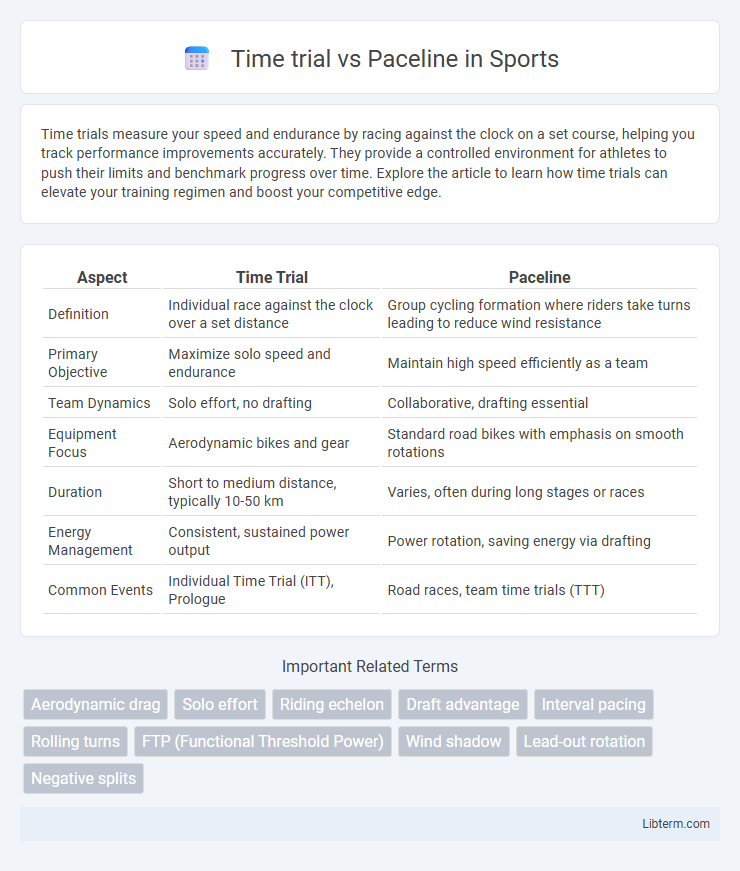Time trials measure your speed and endurance by racing against the clock on a set course, helping you track performance improvements accurately. They provide a controlled environment for athletes to push their limits and benchmark progress over time. Explore the article to learn how time trials can elevate your training regimen and boost your competitive edge.
Table of Comparison
| Aspect | Time Trial | Paceline |
|---|---|---|
| Definition | Individual race against the clock over a set distance | Group cycling formation where riders take turns leading to reduce wind resistance |
| Primary Objective | Maximize solo speed and endurance | Maintain high speed efficiently as a team |
| Team Dynamics | Solo effort, no drafting | Collaborative, drafting essential |
| Equipment Focus | Aerodynamic bikes and gear | Standard road bikes with emphasis on smooth rotations |
| Duration | Short to medium distance, typically 10-50 km | Varies, often during long stages or races |
| Energy Management | Consistent, sustained power output | Power rotation, saving energy via drafting |
| Common Events | Individual Time Trial (ITT), Prologue | Road races, team time trials (TTT) |
Introduction to Time Trial and Paceline
Time trials and pacelines are two distinct cycling formats emphasizing different strategies and skills. A time trial involves solo riders racing against the clock over a set distance, prioritizing sustained power output and aerodynamic positioning. In contrast, a paceline is a group riding technique where cyclists take turns leading to reduce wind resistance, optimizing speed and energy efficiency through teamwork.
Defining Time Trial: Solo Against the Clock
A time trial is a cycling race format where a rider competes solo against the clock, aiming to complete a set course in the shortest time possible without drafting or support from others. This contrasts with a paceline, where a group of cyclists rotates the lead to reduce wind resistance and maintain higher speeds collaboratively. Time trials emphasize individual endurance, pacing strategy, and aerodynamics, highlighting the rider's raw power and time management skills.
Understanding Paceline: Group Riding Dynamics
Paceline riding maximizes aerodynamic efficiency by positioning cyclists in a single file, reducing wind resistance through drafting. Each rider takes turns leading at the front, expending more energy while allowing teammates behind to conserve stamina. Precise communication and smooth rotations are essential for maintaining speed and safety in a paceline.
Key Differences Between Time Trial and Paceline
Time trials prioritize individual performance against the clock, with riders maintaining an aerodynamic position to minimize drag and maximize speed over a set distance. In contrast, pacelines emphasize group dynamics, where cyclists ride closely together to reduce wind resistance through drafting, allowing for energy conservation and sustained higher speeds. Equipment and tactics differ as time trials often feature specialized bikes and aerodynamic gear, while pacelines rely more on coordinated teamwork and strategic rotation among riders.
Equipment and Bike Setup Comparisons
Time trial bikes feature aerodynamic frames, integrated handlebars, and deep-section wheels optimized for minimizing drag and maintaining high speeds during solo efforts. Paceline setups prioritize versatility and comfort, often using lighter frames, standard drop handlebars, and shallower rims to balance aerodynamics with maneuverability in group riding. Equipment choices like shoe cleats and clothing also differ, with time trial gear emphasizing form-fitting suits and stiff-soled shoes to maximize power transfer and aero efficiency.
Aerodynamics: Individual vs Collective Advantage
Time trial cycling emphasizes aerodynamic efficiency for the individual rider, prioritizing a streamlined position and specialized equipment to minimize drag and maintain high speeds. In contrast, paceline riding leverages collective aerodynamics, where riders cycle closely in a line, reducing air resistance for those behind the leader, which enhances overall group efficiency. This formation allows energy savings of up to 30% for trailing cyclists, enabling sustained higher speeds compared to solo efforts.
Tactical Approaches in Each Discipline
Time trial tactics emphasize consistent power output and aerodynamic positioning to minimize drag and maintain steady pacing throughout the course. Paceline strategies prioritize drafting efficiency, smooth rotations, and communication to conserve energy and maximize group speed. Understanding wind direction and rider strengths plays a critical role in optimizing performance in both disciplines.
Training Requirements for Time Trial vs Paceline
Training for a time trial emphasizes individual power output, aerodynamic positioning, and sustained threshold efforts to maintain a consistent high pace over a set distance. Paceline training requires focused group riding skills, including smooth drafting techniques, precise communication, and seamless rotations to conserve energy and maximize speed. Time trialists prioritize repetitive interval sessions and aerodynamic efficiency, while paceline riders develop teamwork, tactical awareness, and short bursts of power for surges and lead changes.
Common Challenges and Mistakes
Time trials and pacelines both demand precise pacing strategies, but common challenges include maintaining consistent power output in time trials and effectively communicating within the group during pacelines. Mistakes often involve starting too fast in time trials which leads to early fatigue, while in pacelines, poor drafting technique and failure to rotate smoothly can increase energy expenditure and reduce group efficiency. Mastery of aerodynamic positioning and clear signaling minimizes these errors and enhances overall performance in both formats.
Choosing the Right Strategy for Your Goals
Time trials demand sustained power output and aerodynamic efficiency to maximize individual speed against the clock, while paceline riding leverages group dynamics and drafting to conserve energy over longer distances. Selecting the right strategy depends on your specific goals: prioritize time trials for improving solo performance and pacing precision, or embrace pacelines to enhance teamwork, endurance, and tactical positioning in group rides. Tailoring your approach to the event format and desired outcome ensures optimal performance and goal achievement.
Time trial Infographic

 libterm.com
libterm.com